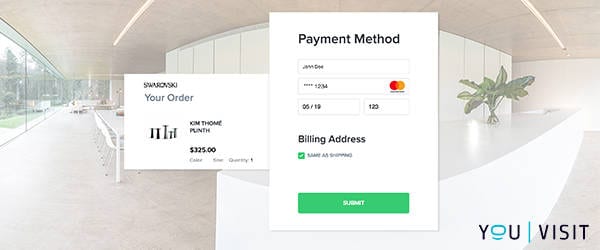V-commerce, the buying and selling of products and services in virtual and augmented reality, is finally becoming a practical reality.
According to a study from Ericsson ConsumerLab, shopping is the top service smartphone users want from VR. The report found that 64 percent of respondents would like the ability to see an item’s actual size and form when shopping virtually. Further, Goldman Sachs estimates that the VR retail market will rise to $1.6 billion by 2025. And according to Walker Sands, more than a third of consumers (35 percent) say they would shop more online if they could try on a product virtually.
The changing retail landscape
So what does this research mean for brands? It signals a change in consumer behavior. Consumers can now have a virtual reality shopping experience anywhere, with their VR headset, smartphone, or desktop computer. V-commerce allows the opportunity to shop as if they were in the store, 24/7, without having to wait for a store to open.
YouVisit is one of the companies on the forefront of v-commerce, recently introducing a seamless virtual shopping experience for Atelier Swarovski Home in partnership with Mastercard.

Many of Swarovski’s items are crystal, fragile, and rare. Shopping in VR allows more consumers to view these items without having to travel to a showroom. The virtual shopping experience reduces the need for delicate items to be shipped around the world and allows customers in L.A. to look at a one-of-a-kind item in Europe, just as if they were there in person.
What marketers need to know
Marketers need to know that v-commerce is more than browsing products in a 3D environment. To be a successful business strategy, the purchasing experience itself needs to be accessible and convenient, too. As immersive technologies move forward, VR and AR won’t just be an additional tactic, they’ll become a key strategy of the customer journey.
Last year, eBay introduced a VR app through which shoppers can browse items and view their features as if they were in a store. A user could also use their gaze to scroll through the items, which allows marketers to see what their customers are searching for, track shopping patterns, and adjust sales strategies and tactics based on shopper behaviors. According to a brandchannel article, Alibaba’s Buy+ VR shopping experience “lets users browse products from bags to shoes to lingerie and call for virtual models to showcase the apparel and accessories on a catwalk. Shoppers can then cycle through additional features with more product detail and add an item to their shopping cart or buy it.”
The time is now
Marketers should be cultivating a plan to implement VR and AR into their shopper marketing strategy now. Brands can use v-commerce to help the customer connect with the products or services they’re evaluating, all the while providing a futuristic buying experience. As immersive technologies help transform e-commerce into v-commerce, there’s no doubt that consumers’ buying behaviors will change. Brands that are ready for this new iteration in shopping technology will reap the benefits.
Cathy Hackl (@CathyHackl) is an Emmy-nominated communicator turned virtual reality and augmented reality speaker and futuristic content creator. She’s also the founder of Latinos in VR/AR and one of the women leading the virtual revolution.